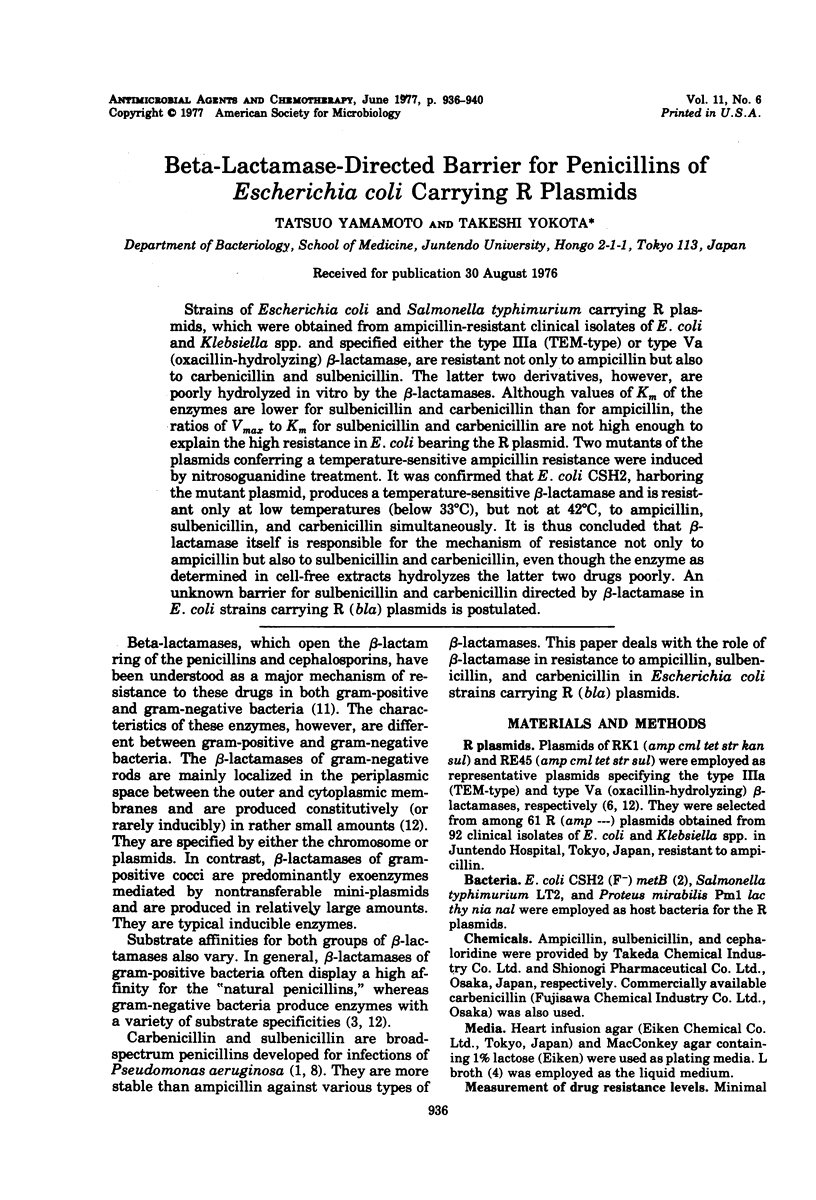Abstract
Strains of Escherichia coli and Salmonella typhimurium carrying R plasmids, which were obtained from ampicillin-resistant clinical isolates of E. coli and Klebsiella spp. and specified either the type IIIa (TEM-type) or type Va (oxacillin-hydrolyzing) β-lactamase, are resistant not only to ampicillin but also to carbenicillin and sulbenicillin. The latter two derivatives, however, are poorly hydrolyzed in vitro by the β-lactamases. Although values of Km of the enzymes are lower for sulbenicillin and carbenicillin than for ampicillin, the ratios of Vmax to Km for sulbenicillin and carbenicillin are not high enough to explain the high resistance in E. coli bearing the R plasmid. Two mutants of the plasmids conferring a temperature-sensitive ampicillin resistance were induced by nitrosoguanidine treatment. It was confirmed that E. coli CSH2, harboring the mutant plasmid, produces a temperature-sensitive β-lactamase and is resistant only at low temperatures (below 33°C), but not at 42°C, to ampicillin, sulbenicillin, and carbenicillin simultaneously. It is thus concluded that β-lactamase itself is responsible for the mechanism of resistance not only to ampicillin but also to sulbenicillin and carbenicillin, even though the enzyme as determined in cell-free extracts hydrolyzes the latter two drugs poorly. An unknown barrier for sulbenicillin and carbenicillin directed by β-lactamase in E. coli strains carrying R (bla) plasmids is postulated.
Full text
PDF




Selected References
These references are in PubMed. This may not be the complete list of references from this article.
- Acred P., Brown D. M., Knudsen E. T., Rolinson G. N., Sutherland R. New semi-synthetic penicillin active against Pseudomonas pyocyanea. Nature. 1967 Jul 1;215(5096):25–30. doi: 10.1038/215025a0. [DOI] [PubMed] [Google Scholar]
- Bachmann B. J. Pedigrees of some mutant strains of Escherichia coli K-12. Bacteriol Rev. 1972 Dec;36(4):525–557. doi: 10.1128/br.36.4.525-557.1972. [DOI] [PMC free article] [PubMed] [Google Scholar]
- Dale J. W., Smith J. T. R-factor-mediated beta-lactamases that hydrolyze oxacillin: evidence for two distinct groups. J Bacteriol. 1974 Aug;119(2):351–356. doi: 10.1128/jb.119.2.351-356.1974. [DOI] [PMC free article] [PubMed] [Google Scholar]
- LENNOX E. S. Transduction of linked genetic characters of the host by bacteriophage P1. Virology. 1955 Jul;1(2):190–206. doi: 10.1016/0042-6822(55)90016-7. [DOI] [PubMed] [Google Scholar]
- LOWRY O. H., ROSEBROUGH N. J., FARR A. L., RANDALL R. J. Protein measurement with the Folin phenol reagent. J Biol Chem. 1951 Nov;193(1):265–275. [PubMed] [Google Scholar]
- Matthew M., Hedges R. W. Analytical isoelectric focusing of R factor-determined beta-lactamases: correlation with plasmid compatibility. J Bacteriol. 1976 Feb;125(2):713–718. doi: 10.1128/jb.125.2.713-718.1976. [DOI] [PMC free article] [PubMed] [Google Scholar]
- Mise K., Suzuki Y. Temperature-sensitive chloramphenicol acetyltransferase from Escherichia coli carrying mutant R factors. J Bacteriol. 1968 Jun;95(6):2124–2130. doi: 10.1128/jb.95.6.2124-2130.1968. [DOI] [PMC free article] [PubMed] [Google Scholar]
- Morimoto S., Nomura H., Fugono T., Minami I., Ishiguro T. Semisynthetic beta-lactam antibiotics. 3. Structure-activity relationships of alpha-sulfopenicillins. J Antibiot (Tokyo) 1973 Mar;26(3):146–152. [PubMed] [Google Scholar]
- POLLOCK M. R. PURIFICATION AND PROPERTIES OF PENICILLINASES FROM TWO STRAINS OF BACILLUS LICHENIFORMIS: A CHEMICAL, PHYSICOCHEMICAL AND PHYSIOLOGICAL COMPARISON. Biochem J. 1965 Mar;94:666–675. doi: 10.1042/bj0940666. [DOI] [PMC free article] [PubMed] [Google Scholar]
- Richmond M. H. Beta-lactamase (Escherichia coli R+TEM. Methods Enzymol. 1975;43:672–677. doi: 10.1016/0076-6879(75)43132-9. [DOI] [PubMed] [Google Scholar]
- Richmond M. H., Curtis N. A. The interplay of beta-lactamases and intrinsic factors in the resistance of gram-negative bacteria to penicillins and cephalosporins. Ann N Y Acad Sci. 1974 May 10;235(0):553–568. doi: 10.1111/j.1749-6632.1974.tb43290.x. [DOI] [PubMed] [Google Scholar]
- Yamagishi S., O'Hara K., Sawai T., Mitsuhashi S. The purification and properties of penicillin beta-lactamases mediated by transmissible R factors in Escherichia coli. J Biochem. 1969 Jul;66(1):11–20. doi: 10.1093/oxfordjournals.jbchem.a129111. [DOI] [PubMed] [Google Scholar]


